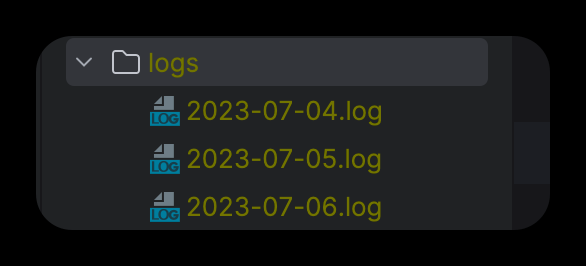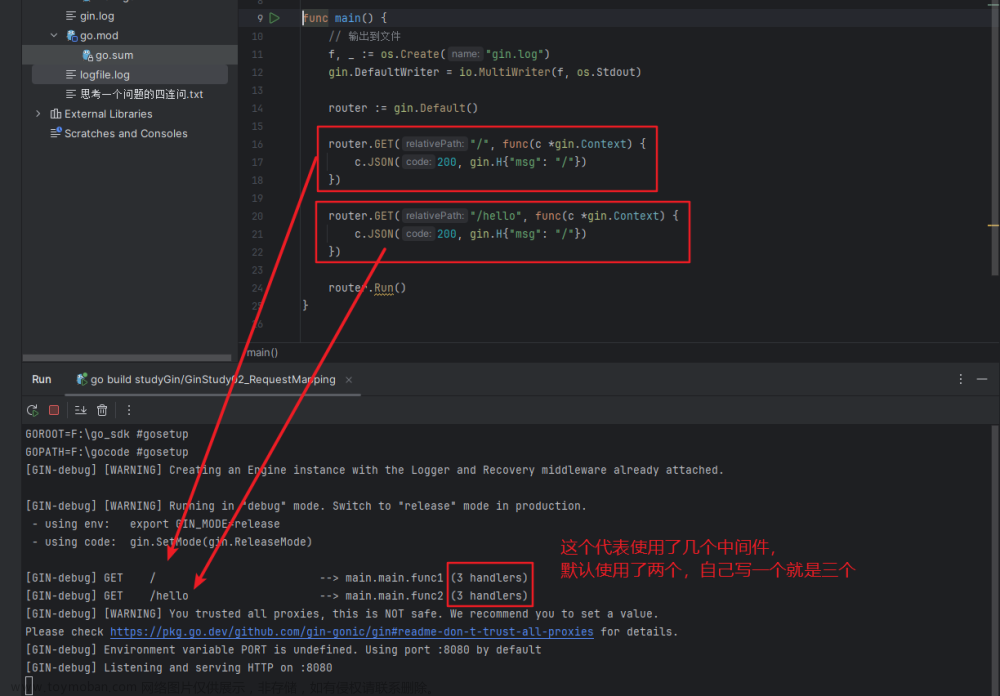前言
日志可以用于排查bug。在C++中,我尝试过:boost log简介、spdlog日志库的封装使用。但我还是比较喜欢plog,因为它简单。
Go 标准库提供了一个日志库log。它的使用可见:Go 每日一库之 log。但是,它有个致命的缺点,没有日志等级。它可以很好的用于日常写demo,但是不适合稍微大点的代码。
参考在Github中stars数最多的Go日志库集合,本文尝试logrus。
Logrus入门
本节内容翻译/摘录自:Sirupsen/logrus、Go 每日一库之 logrus
Logrus 是 Go (golang)的结构化日志记录器,完全兼容标准库日志记录器的 API。
Logrus 进入维护模式。我们不会引入新的特性。因为它已经被很多项目依赖。引入新特性,可能会破坏他们的项目,这是不希望发生的事情。这并不意味着 Logrus 死了。Logrus 将继续保持安全性、(向后兼容的) bug 修复和性能(在这些方面我们受到接口的限制)。我认为,Logrus 最大的贡献在于,在 Golang 结构化日志的广泛应用中发挥了一定作用。似乎没有理由在 Logrus V2中进行重大的、突破性的迭代,因为出色的 Go 社区已经独立地构建了这些迭代。社区中也有很多优秀的日志库,如Zerolog、 Zap 和 Apex。
设置日志等级
设置日志等级未debug。
package main
import (
"github.com/sirupsen/logrus"
)
func main() {
logrus.SetLevel(logrus.DebugLevel)
logrus.Trace("trace msg")
logrus.Debug("debug msg")
logrus.Info("info msg")
logrus.Warn("warn msg")
logrus.Error("error msg")
logrus.Fatal("fatal msg")
logrus.Panic("panic msg")
}
默认输出到标准输出。输入内容如下。
DEBU[0000] debug msg
INFO[0000] info msg
WARN[0000] warn msg
ERRO[0000] error msg
FATA[0000] fatal msg
exit status 1
设置输出格式
上面默认使用的时logrus.SetFormatter(&logrus.TextFormatter{}),输出在tty中会有颜色。我们也可以设置为logrus.SetFormatter(&logrus.JSONFormatter{})格式,将字段记录为 JSON。其他的第三方format见官网。也可以自定义format。
package main
import (
"github.com/sirupsen/logrus"
)
func main() {
logrus.SetLevel(logrus.DebugLevel)
logrus.SetFormatter(&logrus.JSONFormatter{})
// logrus.SetFormatter(&logrus.TextFormatter{})
logrus.Trace("trace msg")
logrus.Debug("debug msg")
logrus.Error("error msg")
}
输出如下。
{"level":"debug","msg":"debug msg","time":"2023-08-09T18:37:58+08:00"}
{"level":"error","msg":"error msg","time":"2023-08-09T18:37:58+08:00"}
设置输出文件名和函数
package main
import (
"github.com/sirupsen/logrus"
)
func main() {
logrus.SetLevel(logrus.DebugLevel)
logrus.SetFormatter(&logrus.TextFormatter{})
// logrus.SetFormatter(&logrus.TextFormatter{
// DisableColors: true,
// FullTimestamp: true,
// })
logrus.SetReportCaller(true)
logrus.Trace("trace msg")
logrus.Debug("debug msg")
logrus.Error("error msg")
}
输入如下。
DEBU[0000]/xxx/demo-2/15-go-Logrus/demo-1.go:17 main.main() debug msg
ERRO[0000]/xxx/demo-2/15-go-Logrus/demo-1.go:18 main.main() error msg
添加字段
package main
import (
log "github.com/sirupsen/logrus"
)
func main() {
log.SetLevel(log.DebugLevel)
// log.SetFormatter(&log.TextFormatter{})
// log.SetReportCaller(true)
log.WithFields(log.Fields{
"animal": "walrus",
}).Debug("A walrus appears")
contextLogger := log.WithFields(log.Fields{
"common": "this is a common field",
"other": "I also should be logged always",
})
contextLogger.Info("I'll be logged with common and other field")
contextLogger.Info("Me too")
}
输出如下。
DEBU[0000] A walrus appears animal=walrus
INFO[0000] I'll be logged with common and other field common="this is a common field" other="I also should be logged always"
INFO[0000] Me too common="this is a common field" other="I also should be logged always"
使用新的logger实例
package main
import (
"os"
log "github.com/sirupsen/logrus"
)
// Create a new instance of the logger. You can have any number of instances.
var FileLog = log.New()
func main() {
file, err := os.OpenFile("logrus.log", os.O_CREATE|os.O_WRONLY|os.O_APPEND, 0666)
if err == nil {
FileLog.SetOutput(file)
} else {
FileLog.Info("Failed to log to file, using default stderr")
}
FileLog.SetFormatter(&log.TextFormatter{})
FileLog.SetLevel(log.DebugLevel)
FileLog.Debug("hello world")
}
日志输出到文件中。
其他-略
- hook: 每条日志输出前都会执行钩子的特定方法。
- Logger 作为 io.Writer
- 本身不提供日志Rotation。
- 工具:通过配置文件初始化logger
- Logrus 可以注册一个或多个在记录任何致命级别消息时将调用的函数
- 默认情况下,Logger 受并发写操作的mutex保护。
一般实践
我习惯了plog的日志输出,包含:时间,等级,进程id,输出日志的函数以及所在行,日志信息。最后,日志文件可以回滚。
使用第三方nested-logrus-formatter设置格式。使用lumberjack控制日志回滚。示例如下:
package main
import (
nested "github.com/antonfisher/nested-logrus-formatter"
log "github.com/sirupsen/logrus"
"gopkg.in/natefinch/lumberjack.v2"
)
func init() {
logger := &lumberjack.Logger{
Filename: "logrus.log",
// 单位是 MB
MaxSize: 500,
// 最大过期日志保留的个数
MaxBackups: 3,
// 保留过期文件的最大时间间隔,单位是天
MaxAge: 28, //days
// 是否需要压缩滚动日志, 使用的 gzip 压缩
Compress: true, // disabled by default
}
log.SetOutput(logger)
log.SetFormatter(&nested.Formatter{
NoColors: true,
HideKeys: true,
ShowFullLevel: true,
})
log.SetReportCaller(true)
log.SetLevel(log.DebugLevel)
}
func main() {
log.Debug("hello world")
}
输出到文件中,如下:文章来源:https://www.toymoban.com/news/detail-636982.html
Aug 9 18:32:44.025 [DEBUG] hello world (/xxx/demo-2/15-go-Logrus/demo-1.go:33 main.main)
Level: true,
})
log.SetReportCaller(true)
log.SetLevel(log.DebugLevel)
}
func main() {
log.Debug("hello world")
}
输出到文件中,如下:文章来源地址https://www.toymoban.com/news/detail-636982.html
Aug 9 18:32:44.025 [DEBUG] hello world (/xxx/demo-2/15-go-Logrus/demo-1.go:33 main.main)
到了这里,关于go入门实践三-go日志库-Logrus入门教程的文章就介绍完了。如果您还想了解更多内容,请在右上角搜索TOY模板网以前的文章或继续浏览下面的相关文章,希望大家以后多多支持TOY模板网!













